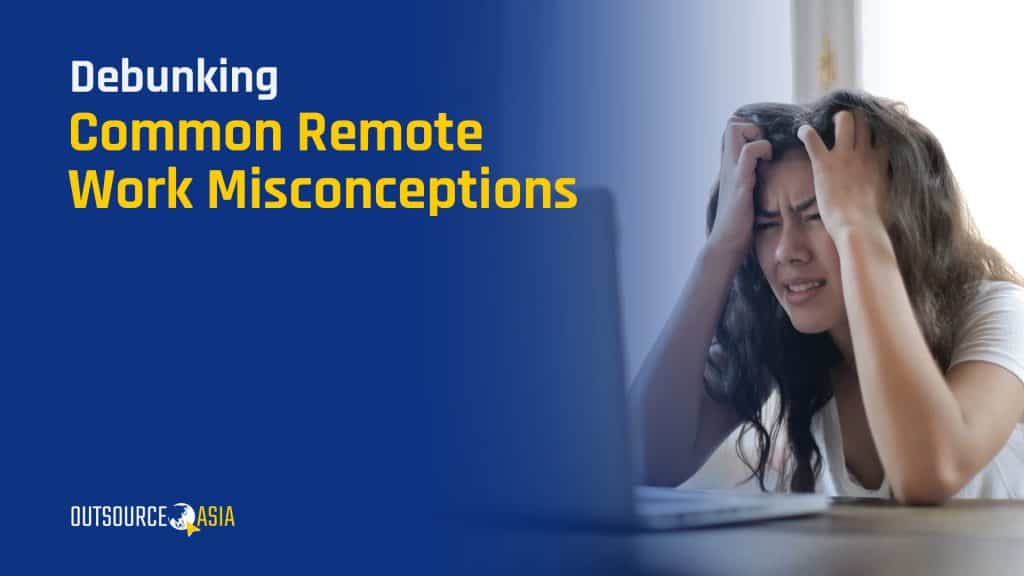
Debunking Common Remote Work Misconceptions
In light of the COVID-19 pandemic, many businesses around the world have chosen to allow employees to work from home. Even well-respected tech CEOs have taken the lead in implementing long-term remote work policies to continue business operations. Working remotely has traditionally held a bad reputation, but not all stereotypes surrounding remote work culture are based on truth. It’s time to put these five misconceptions to rest.
Misconception # 1: Remote workers are slackers.
There’s a common misconception that if you can’t physically see employees getting busy at their desk, then they’re getting less work done.
Any individual, regardless of location, can be at risk of being unproductive if team leaders will or have not set out clear expectations, deadlines, and long-term objectives about projects.
Yes, there might be those that are guilty of slacking off or are just intentionally messing around at doing their job properly – but it’s got nothing to do with whether they’re inside an office building where the boss can see them or at home surrounded by no one.
However, research proves it: remote workers are more productive in work-from-home setup and that they can get more things done in less time. Unlike people in a traditional 8-to-5 office job, they’re not caught up in stressful commutes, they took fewer sick days, and that they don’t have to deal with office politics or interruptions from colleagues.
This doesn’t say that remote workers cannot be distracted by other things or that they are immune to productivity slump from time to time, according to this study. But these two important things can ensure that they will remain engaged and efficient in their assigned tasks: first, they need to accept their shared responsibility by meeting expectations for the sake of the team; and second, they need to be assured that they can achieve work/life balance despite demanding work outputs.
Not everyone is destined to be an excellent remote worker. It is important, therefore, to hire the right person for the job. And when you find those people who are willing to commit to produce quality work and move forward together, location becomes irrelevant to productivity.
Misconception # 2: Communication and collaboration suffers in a remote work setup.
Just because an employee is in a virtual setting, it doesn’t mean that it’s difficult to reach out to them or that they are unreliable when it comes to meeting deadlines and milestones.
Contrary to common misconceptions, remote work allows communication and collaboration to flourish even better than when in an office setting. This is because of the availability of digital tools and online-conferencing platforms that can be leveraged to discuss things about and keep tab on everyone’s progress.
Looking for the best-in-class cloud-based communication and collaboration platform out there? Microsoft Office 365 can make this happen. Conversations can be organized in teams and channels; video calls can be made fun and professional-looking with its background blur feature among other functions; transfer, access, and storage of files and data are secure and seamlessly integrated; document editing and co-authoring are done in real-time. And there’s so much more it can offer!
As long as remote workers have the right home office setup in position and are maximizing the digital resources at hand, there’s nothing that can get in the way of making their presence felt or update their team members of your progress for the day.
Note: If your organization handles sensitive company data or customer/client personal information, make sure to use a fully encrypted communication and collaboration platform to prevent cybercriminals from gaining access or control to it.
Misconception # 3: Companies don’t like or hire remote workers.
This is another common misconception about remote work. But the truth is, an increasing number of businesses are adopting the remote working strategy even before the coronavirus pandemic has erupted.
One UK-based study shows that a quarter of British employees are in a flexible working arrangement and that the Office of National Statistics predicted that as much as 50% of Britain’s workforce will telecommute by 2020.
In the U.S. alone, remote work has skyrocketed to at least 150% increase between 2005 and 2017 while data has made it clear that the number of virtual employees will still go higher in the coming years.
Small businesses have already favored employing remote workers in the past and will continue to do so especially when it brings tremendous savings in many aspects for the company. Big firms and enterprises, on the other hand, are ramping up their remote workforce mainly to avoid spreading the virus. More than that, it means easier access to a larger talent pool, higher retention or lower turnover rate, and that telecommuters are eager to go above and beyond the call of duty.
Misconception # 4: Remote work weakens and/or damages company culture.
Traditionally, companies are highly dependent on a face-to-face setting to foster a perceived company culture. The requisite Friday night drinks, annual office holiday parties, and corporate retreats – these are just some of the ways they think a strong employer-employee/employee-employee relationship is created.
Remote work, therefore, is associated with foregoing fun social encounters, missing out on team rapport, and eventually ruining company culture. Whatever notion you have about it, the truth is it goes beyond free food, fancy perks, and casual dress codes.
With proper planning, it is easy to create a vibrant and strong company culture for all virtual employees! The key is to ensure that remote workers feel appreciated, look up to the leadership, and are happy to stay in their given position.
Misconception # 5: You’re always on the clock when you work remotely.
Just because remote workers have a flexible schedule at home or anywhere around the world doesn’t mean they are on-call. Yes, there are telecommuting and work from home arrangements that require employees to work for a specific timeframe within the day or be in contact during set hours but they are not obligated to be available 24/7.
One of the main reasons why many individuals have sought for remote work opportunities is so they don’t have to punch in and out of daily office shifts, much more work round the clock.
The biggest benefit of remote work is that it provides freedom and flexibility; however, this is best enjoyed by employees who can impose self-discipline and personal accountability – those that are good at keeping up with the demands of the job or avoid missing deadlines.
Nothing is more satisfying for remote workers than being able to log in and out of work if and when they want to. Those extra hours usually spent being stuck in traffic or fussing about an office-appropriate outfit can be used for simple pleasures such as walking the dog in the mornings, indulging in a late afternoon workout session, or spending more quality time with the kids over the weekend.
Future Proof Your Business
Remote work and outsourcing are revolutionizing the way we work in a post-pandemic world. Knowing the key differences between these services and which will best complement your organizational setup can undoubtedly have positive impact in productivity, profitability, and future business growth. If you’re ready to explore the benefits of a remote team, schedule a call with us and let us start discussing your options.



